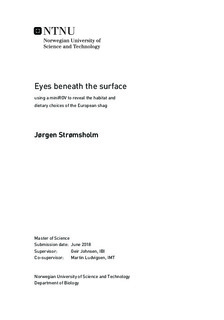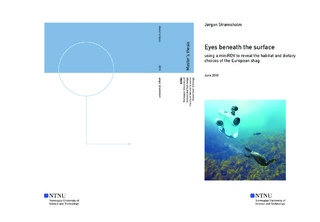| dc.description.abstract | The population of sea birds in Norway is drastically declining, and numbers of breeding European shag (Phalacrocorax aristotelis) in the nesting colony in Runde, Norway, has declined with ~96% in the last 40 years. Mapping and monitoring marine habitats are important for a proper marine spatial management, and governmentally funded mapping-programmes are contributing to the knowledge of the deep sea floor. However, shallow coastal habitats (sea floor and kelp forest) off theNorwegian coast, where sea birds forage, have not been mapped leaving large knowledge-gaps. If reasons for the population-decline of sea birds is to be answered and their foraging habitat has to be protected, the knowledge of all trophic levels in the kelp forest ecology, including the prey species for shags in foraging areas, is strongly needed.
The aims of this thesis was to use enabling technology such as a small remotely operated vehicle to map kelp forest and fish species. Instrumented shags were equipped with trackers for geo-position and diving depths. Aerial drones (quadrocopter) were used to give an spatial overview of the foraging area and position of the remotely operated vehicle. The fish prey (species and sizes) for shags were analyzed using fish-otoliths (from regurgitated bird pellets). All information was put together to map the habitat and to reveal the dietary choices of European shag off the coast of Runde in Norway.
Instrumented shags revealed where, how deep and for how long time they dived (indicating a good or bad area to forage in), and showed fidelity for several distinct areas. From imagery gathered by the remotely operated vehicle in one of the areas, 56 % of all fish-observations were at the same depth as European shags dived. From collected pellets in nesting colony, otoliths revealed the species composition (20 % Labridae species, 67 % of Gadidae species and 7 % of Ammodytes species), and size (back-calculation) of prey the European shags foraged on. The calculated mean length of Labridae and Gadidae species was respectively 134.6 mm and 117.3 mm, while the observed mean length from imagery (including the immersion effect of 1.3) was 113.0 mm for both families of fish (however can length of observed fish not be verified as the imagery lacks a size scaling tool for size and distance).
The experimental study approach in this thesis was successful as habitats in exposed-, sheltered-, and close to shore-areas was mapped. The usage of instrumented sea birds allowed us to follow the birds to their preferred foraging depths with technology such as remotely operated vehicle. However, the remotely operated vehicle has its drawbacks (camera and scale measuring tool to name the most pressing) for scientific work. The different mapped habitats was successfully classified using the European Nature Information System classification hierarchy a more complex system than the Norwegian Directorate for Nature Management proposes. As most of the kelp-occurrence in coastal Norway is model-based, this survey will further argue the need for a standard with a better fit for surveys done in shallow water than the current Norwegian Standard or European Standard for habitat mapping. | |

